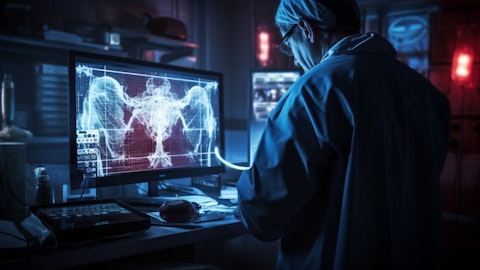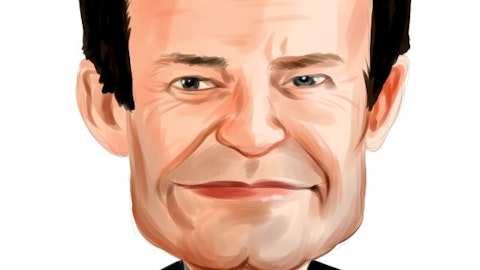And some of that becomes from how we imaging people correctly and we’re referring them correctly at centers. And we can see that, that’s exactly what we see potentially that will happen out with the new therapy of tricuspid in the US. We’ll be able to start building up diagnosis referral to heart teams. And also, we see that there’s an opportunity, as Larry talked about in the investor conference, in the TAVR group, we’re doing so much with patient activation. And we see that all those learnings from patient activations in the future will be able to be leveraged over to the TMTT space, both for mitral and tricuspid to continue to grow the market.
Robbie Marcus: Great. I appreciate that. Maybe one on the TAVR market. We have the exciting data from EARLY TAVR coming later this year at TCT. How do you think about what that does to the TAVR market growth going forward? Do you put up double-digit growth in the fourth quarter? That’s what guidance includes over the next few years for the most part. How do you think about what’s coming from low intermediate and high risk and severe? And then, how do you think about what asymptomatic adds? Is that just what helps keep you at double digit, or can that help accelerate growth? Thanks.
Larry Wood: Yeah. Thanks. This is Larry. That’s a great question. I think the first thing is we’re just going to learn a lot from this trial. There’s a lot of unknown questions out there in terms of what percentage of patients are truly asymptomatic when subjected to a stress test. I think how fast do people progress and what happens to people while they’re waiting. I think the biggest thing about it is, as we’ve talked about, and I spent a lot of time at the investor conference, the time from a patient to get diagnosed or treated is just really long. And a lot of that is the interpretation of the guidelines and this overlay of symptoms. And it’s all really stand in the gears preventing the patients from moving through. And unfortunately, given the deadliness of the disease, a lot of people never actually make it to therapy.
I think with the EARLY TAVR trial, assuming that it’s successful, it will just streamline that process where we can just apply guideline criteria to aortic stenosis, and it won’t require this additional evaluation of symptoms and people can just move through. But remember, only about 13% of patients right now with severe aortic stenosis actually get treated. So there’s a huge under-treatment right now. We think asymptomatic just adds to that.
Bernard Zovighian: In addition, Robbie, what I like is our commitment to — after 20 years of TAVR, we are still super committed to bring big evidence. Look at these two trials, PROGRESS and EARLY TAVR, this is a potential, for sure, to learn more, but also to expand indication to change the guidelines. So, as a leader in the space, for sure, we like it, we are committed. But I believe that in the next 10 years, here in TAVR, we are going to see some very exciting things happening.
Larry Wood: Yeah, I think that’s right. And I think it’s sort of returned to a little bit of the earlier days in TAVR, where I think we’re planning on having a steady cadence of new trials and new data and new evidence that continues to not only raise awareness about the therapy, but also open up new opportunities for patients to get treated that don’t currently get treated today.
Robbie Marcus: Appreciate it. Thank you.
Operator: Our next question comes from Travis Steed with Bank of America. Please state your question.
Travis Steed: Hey, thanks for taking the question. Maybe talking about EVOQUE over a multiyear period, just curious how you think that market develops compared to the mitral market, if you think that goes faster or slower? And when you think about the data that we have so far, it seems like replacement is doing better than clipping. So, I don’t know if you think about the mechanism of action why replacement would be better than clipping and kind of where you see a place for clipping in the market in tricuspid?
Bernard Zovighian: Go ahead?
Daveen Chopra: Yeah. So, I guess I’ll start off with the latter part of your question about the technology. As I kind of mentioned, we see that in replacement where you’re able to really eliminate tricuspid regurgitation, we see an awesome opportunity to help patients and really improve their quality of life. And we see kind of replacement with its broad applicability really being able to treat a large chunk of those tricuspid regurgitations, the vast majority of tricuspid regurgitation patients. But there’s still — but again, based on the disease state and the heterogeneity of tricuspid regurgitation, there’s still going to be many patients where replacement may not make sense for anatomical or other considerations, where whether it’s a clasping technology or other modality may make sense.
Back to your first question about how the market develops related to mitral, I think we see continued strength in this. We think the mitral market had some early strength in kind of slowdown during COVID. We think that the tricuspid market, as referrals and awareness of the disease continues, we’ll continue to kind of grow at a very strong rate at rates that we think they can kind of probably exceed kind of mitral, especially with the two modalities entering the market in a very similar time, you now have an opportunity to treat a larger proportion of patients.
Travis Steed: Helpful. And a follow-up, curious on the SMART trial. If the data there is good? If you think there’s an impact on the market? And then also, there was news last week, when last competitor comes to the market in 2024. Does that change your view on 2025? I’m just curious what kind of competition you had kind of baked into your long-term guidance. Thanks a lot.




